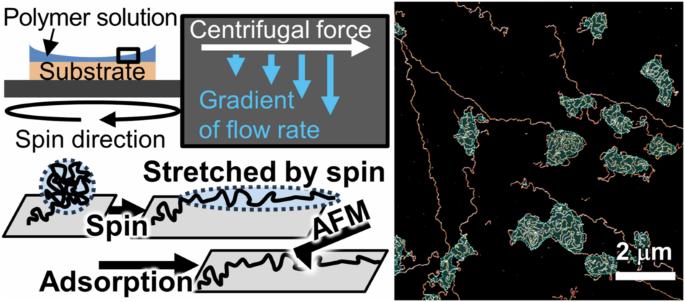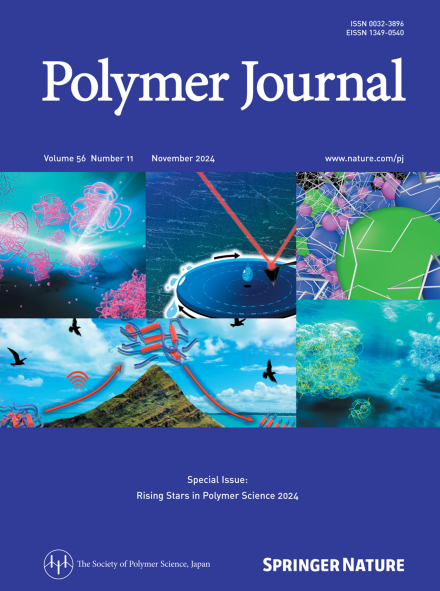Morphologies of polymer chains spun onto solid substrates
IF 2.3
4区 化学
Q3 POLYMER SCIENCE
引用次数: 0
Abstract
External fields are often present when polymers contact solids, potentially affecting chain adsorption onto a substrate. The adsorbed chains, which are difficult to relax thermally, could semipermanently influence the dynamics of the surrounding chains and bulk chains. In this study, we examined the effect of a force field induced by spin coating on the adsorption of a model polymer chain, DNA. Observations using atomic force microscopy indicated that the morphologies of adsorbed chains were affected not only by the force field but also by the incubation time (tinc) after deposition and before spinning. A longer tinc caused a greater amount of chains to transition from being present in two-dimensional random coil states to stretched states. Conversely, shorter tinc values resulted in many chains being adsorbed in a stretched state. The orientations of the stretched chains reflected the presence of competition between the effects of the centrifugal force and those of the flow rate gradient. At tinc = 0, the adsorbed chains were stretched, and they exhibited many kinks. It was anticipated that this macromolecular information could aid in controlling buried morphologies near solid surfaces and in fabricating promising materials, such as polymer composites and layered organic devices. We investigated the effect of a force field induced by spin coating on the adsorption of a model polymer, DNA. Observations using atomic force microscopy indicated that the morphologies of adsorbed chains were affected not only by the force field but also by the incubation time (tinc) after deposition and before spinning. Shorter tinc values resulted in many chains being adsorbed in a stretched state. The orientations of the stretched chains reflected the presence of competition between the effects of the centrifugal force and those of the flow rate gradient.


在固体基底上纺丝的聚合物链的形态
聚合物与固体接触时经常会产生外场,这可能会影响基底上的链吸附。被吸附的链难以热松弛,可能会半永久性地影响周围链和主体链的动力学。在这项研究中,我们考察了自旋涂层诱导的力场对模型聚合物链 DNA 吸附的影响。使用原子力显微镜的观察结果表明,吸附链的形态不仅受到力场的影响,还受到沉积后和旋转前的孵育时间(tinc)的影响。较长的孵育时间会导致更多的链从二维随机线圈状态转变为拉伸状态。相反,较短的 tinc 值会导致许多链以拉伸状态被吸附。拉伸链的取向反映了离心力效应和流速梯度效应之间存在竞争。在 tinc = 0 时,吸附链处于拉伸状态,并呈现出许多扭结。预计这种大分子信息有助于控制固体表面附近的埋藏形态,以及制造聚合物复合材料和层状有机器件等有前途的材料。
本文章由计算机程序翻译,如有差异,请以英文原文为准。
求助全文
约1分钟内获得全文
求助全文
来源期刊

Polymer Journal
化学-高分子科学
CiteScore
5.60
自引率
7.10%
发文量
131
审稿时长
2.5 months
期刊介绍:
Polymer Journal promotes research from all aspects of polymer science from anywhere in the world and aims to provide an integrated platform for scientific communication that assists the advancement of polymer science and related fields. The journal publishes Original Articles, Notes, Short Communications and Reviews.
Subject areas and topics of particular interest within the journal''s scope include, but are not limited to, those listed below:
Polymer synthesis and reactions
Polymer structures
Physical properties of polymers
Polymer surface and interfaces
Functional polymers
Supramolecular polymers
Self-assembled materials
Biopolymers and bio-related polymer materials
Polymer engineering.
 求助内容:
求助内容: 应助结果提醒方式:
应助结果提醒方式:


